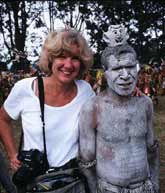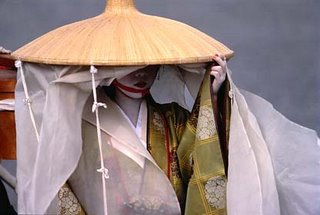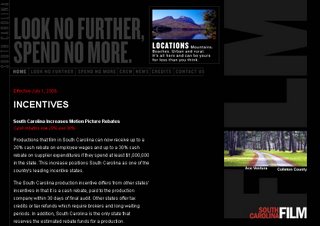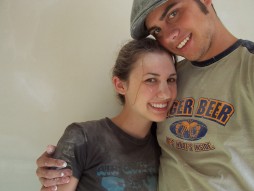
Every year universities give out degrees to distinguished persons from around the globe. This practice gives universities the opportunity to reward outstanding citizens, and to provide students with role models that encompass the values of the institution. It brings these individuals into the school's community, allowing both the nominee and the school to benefit from one another. The
University of Southern California is one of the many universities that follow this practice of conferring honorary degrees. It has bestowed awards on numerous distinguished persons in the last few years, including Neil Armstrong, Michael Eisner, and Barry Munitz. In consideration for the 2007 honorary degree in fine arts from the University of Southern California, I strongly urge the
Office of the Provost to consider the distinguished photojournalist, Jodi Cobb, as a recipient. Not only does Jodi Cobb produce aesthetically pleasing images, but these images teach and call individuals into action for world issues. By reviewing Cobb's qualifications, contributions, and originality of her work; the connections between her and USC will constitute a perfect match.
Jodi Cobb is a supremely qualified person for an honorary degree from USC. Working as a staff photographer for
National Geographic Magazine since 1977, she has traveled the world over for her craft. While she has worked on numerous articles and books with fantastic results, for example her book
Geisha: the Life, the Voices, the Art, and article
Saudi Arabian Women; it is her article "
21st Century Slaves" that has had the biggest impact on the world. Her photos reveal the many types of modern slavery. Like women who have been sold into prostitution, and children sold into sweat shops or begging. Her work follows their struggle as they work off their "debt" to their owner, only to be sold off the moment they have. Described as the "defining story for the modern-day antislavery movement" by writer
John Roach, this article slapped viewers with images of a practice that was thought to have ended in the times of President Lincoln. Cobb's article gave faces to the previously anonymous 27 million effected by this illegal trade, and has called numerous people to action against slavery through her compelling images. This aspect of her life is completely in tune with the
Code of Ethics of the University of Southern California. Under the code, the lines, "we speak out against hatred and bigotry whenever and where ever we find them" and "we do not tolerate ...ill use of our fellow human beings" ring especially true in her work.
Jodi Cobb not only has produced wonderful work, but she has been readily recognized as well. She won the
American Society of Media Photographers Award in 1996 for her Book
Geisha: the Life, the Voices, the Art. She was also named a member of the
United States Presidential Delegation to the 1998 Winter Olympics in Nagano, Japan. Her photography has been in numerous exhibits including the
International Center of Photography in New York, the Corcoran Gallery of Art in Washington, and she has been the subject for a retrospective that was exhibited in Steamboat, Colorado. Jodi Cobb involves herself in the advancement of photography. She teaches workshops about the technical and about aesthetics of photography around the United States. She lectures on the tragedy of modern slavery, and call attention to other issues she has come across in her travels.

There are many advantages and contributions that Jodi Cobb would make to the university by becoming an honorary degree holder. The first of these having to do with the university's appearance and notability. In his book
Liberal Education and the Public Interest, author James O. Freedman notes that honorary degrees are "one way in which universities advertise themselves" (125). He also notes that in these "advertisements" universities can get a bit carried away, honoring mere celebrities, or just as often generous donors. Unfortunately it seems that the University of Southern California might be guilty of
this practice. Alfred E. Mann, Wallis Annenberg and Andrew Viterbi are familiar, not necessarily for their works and goodwill, but for the schools within the university named after them. Freedman explains that, "the original purpose of honoring personal achievement has...some would say been blighted- by the institutional desires to flatter generous donors...to whom more relaxed standards are typically applied" (126). Jodi Cobb would help to steer the college away from this practice. This would allow students to see a true representation of the school's ethics and morals, not just the esteem placed on the monetary value of one's career with little regard to public works. Jodi Cobb is not quite a celebrity, yet her name would generate attention for the university. This is because of the nature of her profession. The name Jodi Cobb is not as recognizable as her work. It is her images that are extremely famous. However, world wide accomplishment is a requirement to the
degree. The university states that one purpose is, "to elevate the university in the eyes of the world by honoring individuals who are widely known and highly regarded for achievements in their respective fields of endeavor" and as mentioned above, Jodi Cobb
has been widely accredited within her field.
Freedman also points out that by honoring the professional, "bonds of friendship and mutual regard between the college and the recipient" are often forged and "in years that follow, honorands often are amenable to ...deliver speeches, appear at symposia, or meet with classes" (130). With this in mind, Jodi Cobb has a lot to offer USC through this relationship. Though her true work may be as a photographer, Cobb's travels have added many new aspects to her career. Her strength in photography would be useful to USC's School of Fine Arts, as well the School of Cinema and Television. She could recount her methods to capturing images that happen by chance. And since both photography and film have the same basic principles (measuring light, depth, framing, etc), both schools would benefit from her teachings. The bulk of Jodi Cobb's work is on "unknown" cultures, so her photography would be useful to students in the visual and cultural anthropology departments. Cobb would be able to recount the different cultures she has encountered (such as women from Saudi Arabia) or the different cultural ideals of beauty around the world. She would be able to help students understand techniques in gathering data in the field, as it is not often an easy task. In an interview for
Nikon Cobb discusses the trouble she had putting together the images for "21st Century Slaves." She explained, "The slaves are a big investment to the slaveholders... They don't welcome a person with a camera." Her methods of managing to infiltrate into these types of areas would be extremely rewarding to the journalist student. Jodi Cobb's contribution potential is very large, expanding over many fields in the same way as her work.

Originality is key to the honorary degree. Described in the University of Southern California's
honorary degree home page, the university requires nominators to answer the question: "What is original about [their] contribution?" So what makes Jodi Cobb's work unique? Many people like Jane Goodall, and film celebrities like Angelina Jolie, speak out against the injustices in the world. However, very few professions expand to cover others in the way that Cobb does. She is a photographer, an artist, a journalist, an anthropologist, and a philanthropist. What makes this truly unique is that it is encompassed in one career, in what Mike W. Martin, author of the book
Meaningful Work: Rethinking Professional Ethics, considers, "role emphasis" (19). But unlike Martin's example of the physician who also takes an active role in medical research, Jodi Cobb's different emphases seem to mesh. On the same day, in the same picture we can see these different aspects.
These aspects can be seen in the picture shown above from the "21st Century Slaves" article. What is first noticeable is the image's over all beauty. It is sharp and the contrast of the small boy's skin to the rich black of his cage all add to a well constructed photograph. This is the photographer and the artist. The subject matter of the photo however, is what elevates it from being simply a great image. It is a boy in a cage from Cobb's "21st Century Slaves" article. So the viewers of the photo do not forget it, Cobb titles her work by describing its content. "In a Refugee Camp in Hong Kong, a Young Vietnamese Awaits Passage to a Free Life in the West," is the title of the above piece. This is the journalist, revealing to us what is actually happening in another part of the world. Her message is aided by the medium. Because of a photograph's inherent "realness," Cobb's work calls people into action in a way that others cannot. The medium also gives it another unique quality. Unlike work by Robert Zimeksis on film, Cobb's work can be understood be everyone. Her message is not obscured by the other aspects such as: narration, continuity, and direction. You don't need to understand science, math, or literature. You do not need an education to understand them because suffering is universal, and that message is what makes her work unique.
However in choosing Jodi Cobb as a recipient for an Honorary degree, one must accept the criticism that might accompany the choice. Some might say that although see does a great job reporting horrible truths like that of current slavery, Jodi Cobb does not seem to devote any personal time trying to help the victims. To this we must realize that her work is a great deal of personal time. Similar to Martin's description of Albert Schweitzer (philanthropist and philosopher) Cobb literally has to "make [her] life [her] argument", as she must travel, live, and probe, to be allowed access to these areas so they can be revealed to the world(18). Others, in review of her book, have accused Cobb of wrongly exploiting the geishas and the women of Saudi Arabia. To them her pictures are unflattering and demystify these women in negative ways. Most notably with the numerous pictures of geisha women in bath houses, smoking. This seems to go against one of the core ideals of
USC's code of ethics that states the, "commitment to respecting the rights and dignity of all persons." However, in her interview with
Nikon Jodi Cobb reveals," You start with one person at a time, tell [them] what you're doing. You have to be honest and upfront with people, and they either accept you or they don't. And if they don't, you move on. There's always another person." It is clear that these women were fully aware of Cobb's motives. If they wished not to be revealed in this way then they would have not agreed to participate. There has also been no criticism from the geisha community.
The
central mission of the University of Southern California as explained by the site is accomplished through "teaching, research, artistic creation, professional practice, and selected forms of public service." Jodi Cobb is a unique nominee who fully embodies this mission through the enrichment of the human mind, and also professionally meets this role through the desired means. Through her photography she has taught thousands about mysterious society of the geisha, the horrifying truth behind modern slavery, as well as broad anthropological studies of beauty. Her work is a tremendous blend of research and art, and her articles has served as a public service to those caught up with in the slave trade. Jodi Cobb gives faces and names to the anonymous. It is for these reasons that Jodi Cobb should be honored and become part of the rich Trojan history.
 Film and photography have always been my life. My father's occupation in the industry has not only instilled in me a love of the medium, but has also keep me in contact with its latest issues. At first the idea of keeping a blog was intimidating since I have never been comfortable sharing my work with even the closest of friends let alone strangers, but the experience allowed me to become an instant authority figure in those subjects I hold so dear. That fact made me strive to "get" people to my site. The blog required many new things that paper essays just do not. My work needed a level of hypertextuality, and a consciousness of visual design in every post as well as in the over all blog. All which were new and unfamiliar to me. One detail of this blog that I feel I have excelled in is my fast exploitation of these items. I tried to use images as much as possible without overwhelming the page, and also chose a design that reflected this emphasis on the visual.
Film and photography have always been my life. My father's occupation in the industry has not only instilled in me a love of the medium, but has also keep me in contact with its latest issues. At first the idea of keeping a blog was intimidating since I have never been comfortable sharing my work with even the closest of friends let alone strangers, but the experience allowed me to become an instant authority figure in those subjects I hold so dear. That fact made me strive to "get" people to my site. The blog required many new things that paper essays just do not. My work needed a level of hypertextuality, and a consciousness of visual design in every post as well as in the over all blog. All which were new and unfamiliar to me. One detail of this blog that I feel I have excelled in is my fast exploitation of these items. I tried to use images as much as possible without overwhelming the page, and also chose a design that reflected this emphasis on the visual. 









